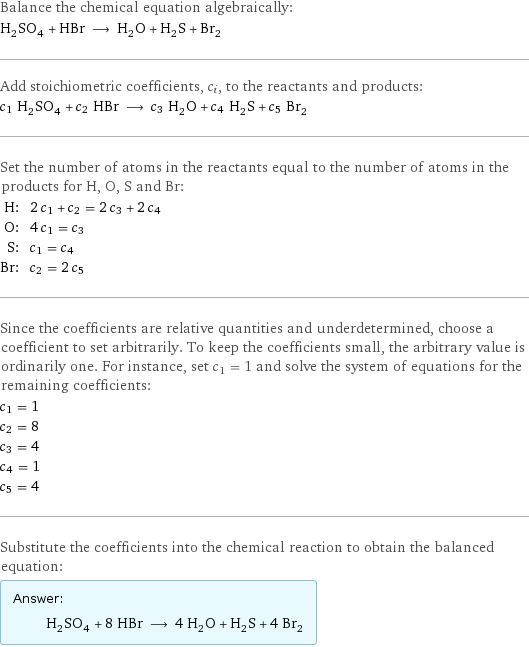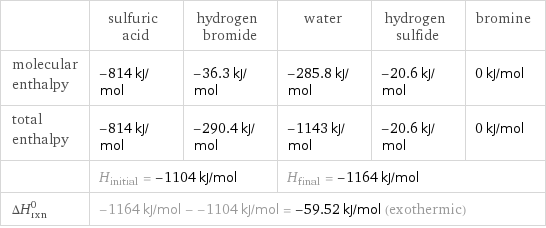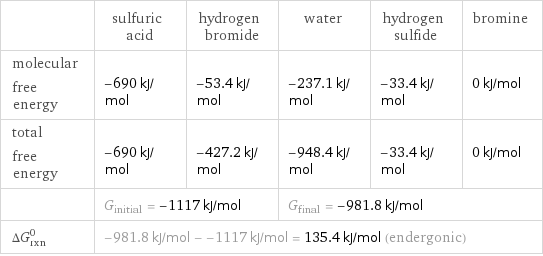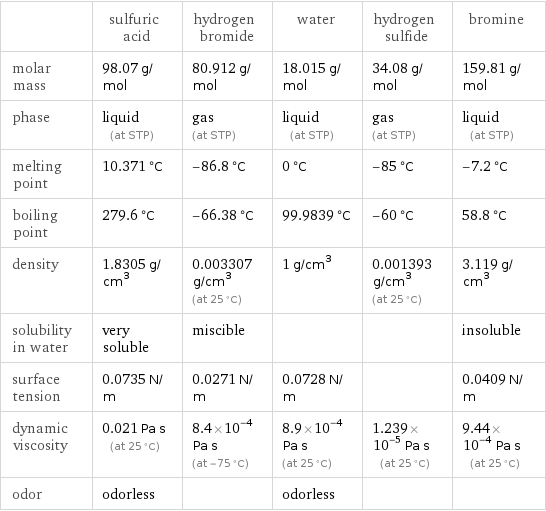Input interpretation

H_2SO_4 sulfuric acid + HBr hydrogen bromide ⟶ H_2O water + H_2S hydrogen sulfide + Br_2 bromine
Balanced equation

Balance the chemical equation algebraically: H_2SO_4 + HBr ⟶ H_2O + H_2S + Br_2 Add stoichiometric coefficients, c_i, to the reactants and products: c_1 H_2SO_4 + c_2 HBr ⟶ c_3 H_2O + c_4 H_2S + c_5 Br_2 Set the number of atoms in the reactants equal to the number of atoms in the products for H, O, S and Br: H: | 2 c_1 + c_2 = 2 c_3 + 2 c_4 O: | 4 c_1 = c_3 S: | c_1 = c_4 Br: | c_2 = 2 c_5 Since the coefficients are relative quantities and underdetermined, choose a coefficient to set arbitrarily. To keep the coefficients small, the arbitrary value is ordinarily one. For instance, set c_1 = 1 and solve the system of equations for the remaining coefficients: c_1 = 1 c_2 = 8 c_3 = 4 c_4 = 1 c_5 = 4 Substitute the coefficients into the chemical reaction to obtain the balanced equation: Answer: | | H_2SO_4 + 8 HBr ⟶ 4 H_2O + H_2S + 4 Br_2
Structures

+ ⟶ + +
Names

sulfuric acid + hydrogen bromide ⟶ water + hydrogen sulfide + bromine
Reaction thermodynamics
Enthalpy

| sulfuric acid | hydrogen bromide | water | hydrogen sulfide | bromine molecular enthalpy | -814 kJ/mol | -36.3 kJ/mol | -285.8 kJ/mol | -20.6 kJ/mol | 0 kJ/mol total enthalpy | -814 kJ/mol | -290.4 kJ/mol | -1143 kJ/mol | -20.6 kJ/mol | 0 kJ/mol | H_initial = -1104 kJ/mol | | H_final = -1164 kJ/mol | | ΔH_rxn^0 | -1164 kJ/mol - -1104 kJ/mol = -59.52 kJ/mol (exothermic) | | | |
Gibbs free energy

| sulfuric acid | hydrogen bromide | water | hydrogen sulfide | bromine molecular free energy | -690 kJ/mol | -53.4 kJ/mol | -237.1 kJ/mol | -33.4 kJ/mol | 0 kJ/mol total free energy | -690 kJ/mol | -427.2 kJ/mol | -948.4 kJ/mol | -33.4 kJ/mol | 0 kJ/mol | G_initial = -1117 kJ/mol | | G_final = -981.8 kJ/mol | | ΔG_rxn^0 | -981.8 kJ/mol - -1117 kJ/mol = 135.4 kJ/mol (endergonic) | | | |
Entropy

| sulfuric acid | hydrogen bromide | water | hydrogen sulfide | bromine molecular entropy | 157 J/(mol K) | 199 J/(mol K) | 69.91 J/(mol K) | 206 J/(mol K) | 152.2 J/(mol K) total entropy | 157 J/(mol K) | 1592 J/(mol K) | 279.6 J/(mol K) | 206 J/(mol K) | 608.9 J/(mol K) | S_initial = 1749 J/(mol K) | | S_final = 1095 J/(mol K) | | ΔS_rxn^0 | 1095 J/(mol K) - 1749 J/(mol K) = -654.4 J/(mol K) (exoentropic) | | | |
Equilibrium constant
![Construct the equilibrium constant, K, expression for: H_2SO_4 + HBr ⟶ H_2O + H_2S + Br_2 Plan: • Balance the chemical equation. • Determine the stoichiometric numbers. • Assemble the activity expression for each chemical species. • Use the activity expressions to build the equilibrium constant expression. Write the balanced chemical equation: H_2SO_4 + 8 HBr ⟶ 4 H_2O + H_2S + 4 Br_2 Assign stoichiometric numbers, ν_i, using the stoichiometric coefficients, c_i, from the balanced chemical equation in the following manner: ν_i = -c_i for reactants and ν_i = c_i for products: chemical species | c_i | ν_i H_2SO_4 | 1 | -1 HBr | 8 | -8 H_2O | 4 | 4 H_2S | 1 | 1 Br_2 | 4 | 4 Assemble the activity expressions accounting for the state of matter and ν_i: chemical species | c_i | ν_i | activity expression H_2SO_4 | 1 | -1 | ([H2SO4])^(-1) HBr | 8 | -8 | ([HBr])^(-8) H_2O | 4 | 4 | ([H2O])^4 H_2S | 1 | 1 | [H2S] Br_2 | 4 | 4 | ([Br2])^4 The equilibrium constant symbol in the concentration basis is: K_c Mulitply the activity expressions to arrive at the K_c expression: Answer: | | K_c = ([H2SO4])^(-1) ([HBr])^(-8) ([H2O])^4 [H2S] ([Br2])^4 = (([H2O])^4 [H2S] ([Br2])^4)/([H2SO4] ([HBr])^8)](../image_source/225fa2384b4d55b57ca9579a94aa9f47.png)
Construct the equilibrium constant, K, expression for: H_2SO_4 + HBr ⟶ H_2O + H_2S + Br_2 Plan: • Balance the chemical equation. • Determine the stoichiometric numbers. • Assemble the activity expression for each chemical species. • Use the activity expressions to build the equilibrium constant expression. Write the balanced chemical equation: H_2SO_4 + 8 HBr ⟶ 4 H_2O + H_2S + 4 Br_2 Assign stoichiometric numbers, ν_i, using the stoichiometric coefficients, c_i, from the balanced chemical equation in the following manner: ν_i = -c_i for reactants and ν_i = c_i for products: chemical species | c_i | ν_i H_2SO_4 | 1 | -1 HBr | 8 | -8 H_2O | 4 | 4 H_2S | 1 | 1 Br_2 | 4 | 4 Assemble the activity expressions accounting for the state of matter and ν_i: chemical species | c_i | ν_i | activity expression H_2SO_4 | 1 | -1 | ([H2SO4])^(-1) HBr | 8 | -8 | ([HBr])^(-8) H_2O | 4 | 4 | ([H2O])^4 H_2S | 1 | 1 | [H2S] Br_2 | 4 | 4 | ([Br2])^4 The equilibrium constant symbol in the concentration basis is: K_c Mulitply the activity expressions to arrive at the K_c expression: Answer: | | K_c = ([H2SO4])^(-1) ([HBr])^(-8) ([H2O])^4 [H2S] ([Br2])^4 = (([H2O])^4 [H2S] ([Br2])^4)/([H2SO4] ([HBr])^8)
Rate of reaction
![Construct the rate of reaction expression for: H_2SO_4 + HBr ⟶ H_2O + H_2S + Br_2 Plan: • Balance the chemical equation. • Determine the stoichiometric numbers. • Assemble the rate term for each chemical species. • Write the rate of reaction expression. Write the balanced chemical equation: H_2SO_4 + 8 HBr ⟶ 4 H_2O + H_2S + 4 Br_2 Assign stoichiometric numbers, ν_i, using the stoichiometric coefficients, c_i, from the balanced chemical equation in the following manner: ν_i = -c_i for reactants and ν_i = c_i for products: chemical species | c_i | ν_i H_2SO_4 | 1 | -1 HBr | 8 | -8 H_2O | 4 | 4 H_2S | 1 | 1 Br_2 | 4 | 4 The rate term for each chemical species, B_i, is 1/ν_i(Δ[B_i])/(Δt) where [B_i] is the amount concentration and t is time: chemical species | c_i | ν_i | rate term H_2SO_4 | 1 | -1 | -(Δ[H2SO4])/(Δt) HBr | 8 | -8 | -1/8 (Δ[HBr])/(Δt) H_2O | 4 | 4 | 1/4 (Δ[H2O])/(Δt) H_2S | 1 | 1 | (Δ[H2S])/(Δt) Br_2 | 4 | 4 | 1/4 (Δ[Br2])/(Δt) (for infinitesimal rate of change, replace Δ with d) Set the rate terms equal to each other to arrive at the rate expression: Answer: | | rate = -(Δ[H2SO4])/(Δt) = -1/8 (Δ[HBr])/(Δt) = 1/4 (Δ[H2O])/(Δt) = (Δ[H2S])/(Δt) = 1/4 (Δ[Br2])/(Δt) (assuming constant volume and no accumulation of intermediates or side products)](../image_source/7a2617990d9397e9a4699955e31ae847.png)
Construct the rate of reaction expression for: H_2SO_4 + HBr ⟶ H_2O + H_2S + Br_2 Plan: • Balance the chemical equation. • Determine the stoichiometric numbers. • Assemble the rate term for each chemical species. • Write the rate of reaction expression. Write the balanced chemical equation: H_2SO_4 + 8 HBr ⟶ 4 H_2O + H_2S + 4 Br_2 Assign stoichiometric numbers, ν_i, using the stoichiometric coefficients, c_i, from the balanced chemical equation in the following manner: ν_i = -c_i for reactants and ν_i = c_i for products: chemical species | c_i | ν_i H_2SO_4 | 1 | -1 HBr | 8 | -8 H_2O | 4 | 4 H_2S | 1 | 1 Br_2 | 4 | 4 The rate term for each chemical species, B_i, is 1/ν_i(Δ[B_i])/(Δt) where [B_i] is the amount concentration and t is time: chemical species | c_i | ν_i | rate term H_2SO_4 | 1 | -1 | -(Δ[H2SO4])/(Δt) HBr | 8 | -8 | -1/8 (Δ[HBr])/(Δt) H_2O | 4 | 4 | 1/4 (Δ[H2O])/(Δt) H_2S | 1 | 1 | (Δ[H2S])/(Δt) Br_2 | 4 | 4 | 1/4 (Δ[Br2])/(Δt) (for infinitesimal rate of change, replace Δ with d) Set the rate terms equal to each other to arrive at the rate expression: Answer: | | rate = -(Δ[H2SO4])/(Δt) = -1/8 (Δ[HBr])/(Δt) = 1/4 (Δ[H2O])/(Δt) = (Δ[H2S])/(Δt) = 1/4 (Δ[Br2])/(Δt) (assuming constant volume and no accumulation of intermediates or side products)
Chemical names and formulas

| sulfuric acid | hydrogen bromide | water | hydrogen sulfide | bromine formula | H_2SO_4 | HBr | H_2O | H_2S | Br_2 Hill formula | H_2O_4S | BrH | H_2O | H_2S | Br_2 name | sulfuric acid | hydrogen bromide | water | hydrogen sulfide | bromine IUPAC name | sulfuric acid | hydrogen bromide | water | hydrogen sulfide | molecular bromine
Substance properties

| sulfuric acid | hydrogen bromide | water | hydrogen sulfide | bromine molar mass | 98.07 g/mol | 80.912 g/mol | 18.015 g/mol | 34.08 g/mol | 159.81 g/mol phase | liquid (at STP) | gas (at STP) | liquid (at STP) | gas (at STP) | liquid (at STP) melting point | 10.371 °C | -86.8 °C | 0 °C | -85 °C | -7.2 °C boiling point | 279.6 °C | -66.38 °C | 99.9839 °C | -60 °C | 58.8 °C density | 1.8305 g/cm^3 | 0.003307 g/cm^3 (at 25 °C) | 1 g/cm^3 | 0.001393 g/cm^3 (at 25 °C) | 3.119 g/cm^3 solubility in water | very soluble | miscible | | | insoluble surface tension | 0.0735 N/m | 0.0271 N/m | 0.0728 N/m | | 0.0409 N/m dynamic viscosity | 0.021 Pa s (at 25 °C) | 8.4×10^-4 Pa s (at -75 °C) | 8.9×10^-4 Pa s (at 25 °C) | 1.239×10^-5 Pa s (at 25 °C) | 9.44×10^-4 Pa s (at 25 °C) odor | odorless | | odorless | |
Units
